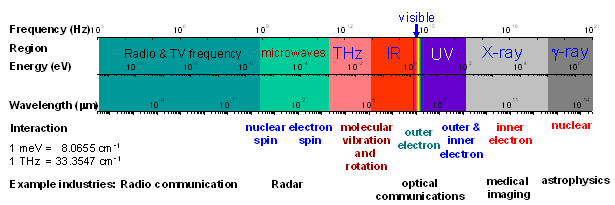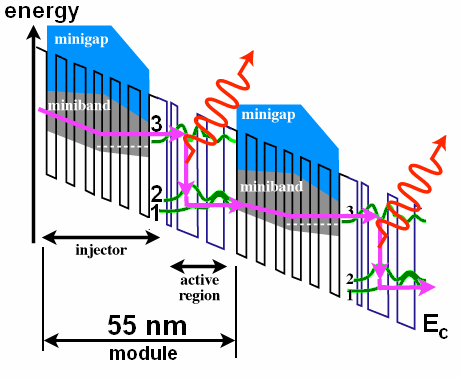RESEARCH INTERESTS
Nanostructures for Terahertz frequencies
Terahertz frequencies
The terahertz (THz or 1012 Hz) region (roughly 200 GHz to 10 THz - or 30 µm to 1.5 mm wavelength) is the part of the electromagnetic spectrum proven to be one of the most elusive, being situated between infrared light and microwave radiation (see Fig. 1). Many complex molecules have rotational and vibrational modes in this region, and many materials such as plastics, clothing, and semiconductors are transparent to terahertz radiation. Terahertz spectroscopy could therefore be used to detect and identify explosives, bioweapons, and narcotics, as well as in cancer screening and proteomics (the study of proteins within the body). Terahertz radiation can also be used for structural imaging, much like x-rays but with greater capabilities. For example, because terahertz radiation is readily absorbed by water, terahertz imaging could be used in dental or skin cancer imaging to differentiate between different tissue types. Security screening with terahertz imaging could detect ceramics as well as metals. Terahertz imaging would also allow nondestructive testing of a wide range of products in production monitoring.

Figure 1: The electromagnetic spectrum. The development of efficient emitters
and detectors within each of the spectral regimes has resulted in the birth of
numerous industries. The search for potential applications of THz radiation is
steadily intensifying as materials research provides improved sources and detectors.
Quantum Cascade Lasers
Following the success of III-V quantum cascade lasers (QCLs) at both mid-infrared and far-infrared (terahertz) frequencies, there is considerable interest in the development of silicon-based quantum cascade devices for low-cost sources and optoelectronic integration with other circuitry. The indirect band gap that has hindered interband emitter development in Si, Si1−xGex, and Ge does not affect QCLs, as they rely on carrier transitions within the same (conduction or valence) band rather than on exciton recombination across the band gap. Indeed, SiGe-based materials have a major advantage over III-V’s for this type of device, in that phonons are nonpolar, and this reduces the principal nonradiative scattering rate that limits the efficiency in III-V devices. This is particularly true at photon energies below the optical phonon energy which range is the subject of the present work. If a QCL could be realized in Si/SiGe, the lack of polar optical phonon scattering, the lower free carrier absorption, and the higher thermal conductivity of Si could allow significantly higher operating temperatures in the terahertz range. Moreover, there could be lower manufacturing costs involved with the mature silicon process technology.

Terahertz photonic crystals
